[국제경영] Starbucks(스타벅스)의 한국 진출 사례 분석
 등록일 / 수정일
등록일 / 수정일 페이지 / 형식
페이지 / 형식 자료평가
자료평가 구매가격
구매가격
- 2010.07.13 / 2019.12.24
- 6페이지 /
 docx (MS워드 2007이상)
docx (MS워드 2007이상) - 평가한 분이 없습니다. (구매금액의 3%지급)
- 1,100원
최대 20페이지까지 미리보기 서비스를 제공합니다.
자료평가하면 구매금액의 3%지급!
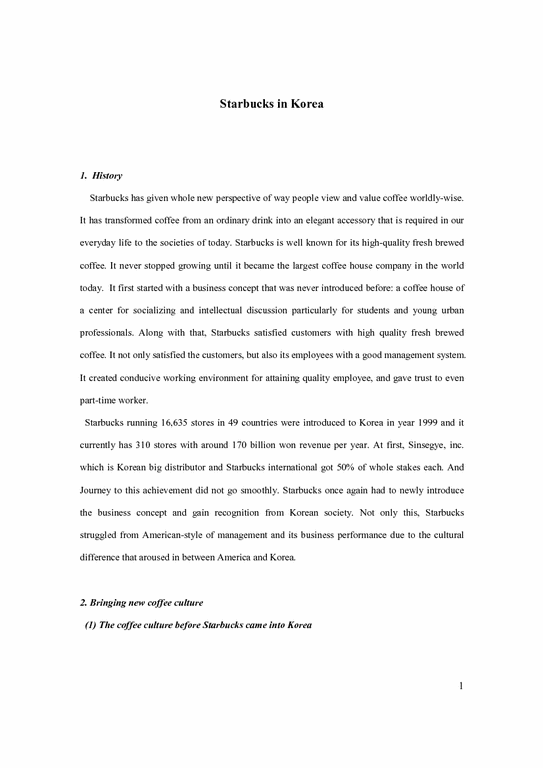 1
1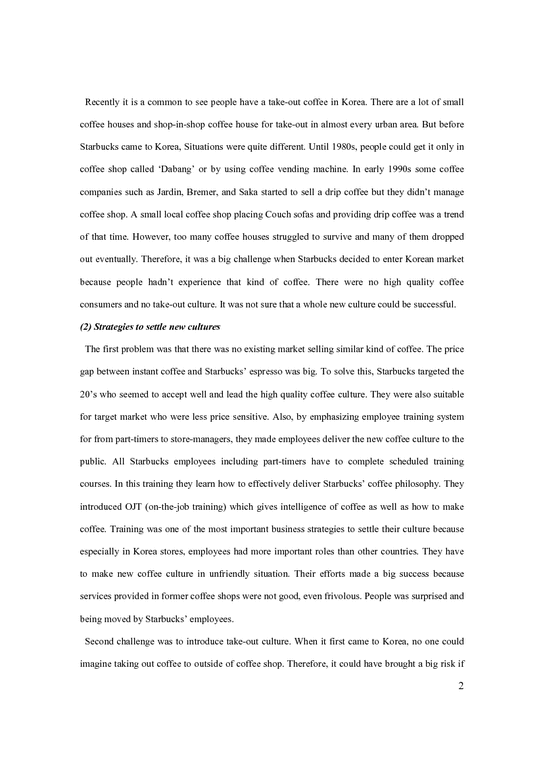 2
2 3
3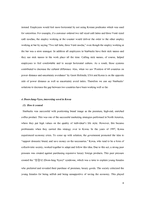 4
4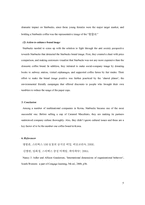 5
5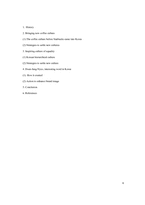 6
6
추천 연관자료
- 목차
-
1. History
2. Bringing new coffee culture
(1) The coffee culture before Starbucks came into Korea
(2) Strategies to settle new cultures
3. Inspiring culture of equality
(1) Korean hierarchical culture
(2) Strategies to settle new culture
4. Doen-Jang-Nyeo, interesting word in Korea
(1) How it created
(2) Action to enhance brand image
5. Conclusion
6. References
- 본문내용
-
(2) Strategies to settle new cultures
The first problem was that there was no existing market selling similar kind of coffee. The price gap between instant coffee and Starbucks’ espresso was big. To solve this, Starbucks targeted the 20’s who seemed to accept well and lead the high quality coffee culture. They were also suitable for target market who were less price sensitive. Also, by emphasizing employee training system for from part-timers to store-managers, they made employees deliver the new coffee culture to the public. All Starbucks employees including part-timers have to complete scheduled training courses. In this training they learn how to effectively deliver Starbucks’ coffee philosophy. They introduced OJT (on-the-job training) which gives intelligence of coffee as well as how to make coffee. Training was one of the most important business strategies to settle their culture because especially in Korea stores, employees had more important roles than other countries. They have to make new coffee culture in unfriendly situation. Their efforts made a big success because services provided in former coffee shops were not good, even frivolous. People was surprised and being moved by Starbucks’ employees.
Second challenge was to introduce take-out culture. When it first came to Korea, no one could imagine taking out coffee to outside of coffee shop. Therefore, it could have brought a big risk if they had introduced take-out shop directly. To minimize cultural shock they made two or three times bigger hall in which more tables and chairs are placed than in U.S. It aimed to make people sit on a chair without feeling unfamiliar and talk each other just like in former coffee shop. Also, at first time they used mug cups to prevent people feel uncomfortable because they might think paper cup is very rude and low quality things. They didn’t force to infuse their culture but tried to make a harmony between their culture and Korean culture. Furthermore, all employees of Starbucks took coffee out on a street when they were going to work. Their cautious but passionate efforts impact Korean drinking culture. At first, people seemed to be embarrassed. Later, however they became excited with unfamiliar coffee names listed on the menu and thought worth to spend money although it was more expensive than one meal.
3. Inspiring culture of equality
(1) Korean hierarchical culture
Historically Koreans are accustomed to hierarchical culture. When Starbucks came to Korea and opened the first store near Ewha women’s Univ. in 1999, Korean hierarchical culture was stronger than now. There were much less multinational companies at that time and most of companies had very strict culture. It was natural that the workforce atmosphere was very different from its home country. Because Starbucks wanted Korean employees to communicate with customers freely and willingly to deliver its own coffee culture, Korean hierarchical culture would be a serious obstacle. Therefore
- 참고문헌
-
맹명관, 스타벅스 100호점의 숨겨진 비밀, 비전코리아, 2005.
김영한, 임희정, 스타벅스 감성 마케팅, 책아책아!, 2003.
Nancy J. Adler and Allison Gundersen, ‘International dimensions of organizational behavior’, South-Western: a part of Cengage learning, 5th ed., 2008, p56.
자료평가
-
아직 평가한 내용이 없습니다.
오늘 본 자료
더보기

최근 판매 자료
- 쿠팡 마케팅 4P전략과 쿠팡 SWOT,STP분석 및 쿠팡 기업현황과 미래전략방향 제시
- 경영전략론_1 산업의 수익을 결정하는 마이클 포터의 5force에 대하여 특정 산업의 예를 들어 설명하시오 2 핵심역량을 결정하는 3가지 요인과 핵심역량 전략에 관하여 사례를 통하여 설명하시오 3 4차 산업혁명에 따른 제품(product) 일하는 과정(process) 요구하는 사람과 깅버문화(people)가 어떻게 변화하여야 하는지에 관한
- [벤처기업][벤처][기업][벤처기업 정의][벤처기업 특징]벤처기업의 정의, 벤처기업의 특징, 벤처기업의 선정범위, 벤처기업의 경제적 효과, 벤처기업의 성장과정, 벤처기업의 기업가정신, 벤처기업의 합병 분석
- [인적자원관리 A+받은자료] 인사고과의 타당성과 신뢰성이 중요한 이유에 대하여 논하시오.
- 창의적사고와프레임워크_디자인씽킹 5단계를 적용해서 해결하기_회사생활 하면서 발견된 문제나 개인적으로 일상에서 경험했던 일 중에 바꾸고 싶거나 개선이 되었으면 좋겠다고 생각한 문제를 어떻게 해결할 것인지 디자인씽킹기법으로 제시하시오
- 1~4주에서 배운 교과 내용을 중심으로 광고를 하나 정해서 광고의 종류가 무엇이며, 어떤
- [브랜드마케팅]국내 캐릭터 산업(마시마로)
- 코스트코 COSTCO 기업 경영전략 사례,SWOT분석,기업소개,핵심역량분석,느낀점
- 삼성전자 인적자원관리의 문제점과 해결방안
- Nucor 경영전략 레포트
저작권 관련 사항 정보 및 게시물 내용의 진실성에 대하여 레포트샵은 보증하지 아니하며, 해당 정보 및 게시물의 저작권과 기타 법적 책임은 자료 등록자에게 있습니다. 위 정보 및 게시물 내용의 불법적 이용, 무단 전재·배포는 금지됩니다. 저작권침해, 명예훼손 등 분쟁요소 발견시 고객센터에 신고해 주시기 바랍니다.









